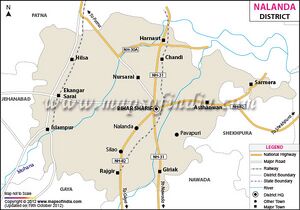Indrasila Guha
| Author:Laxman Burdak, IFS (Retd.) |

Indrasila Guha was one of the Buddhist places visited by Xuan Zang in 637 AD. It was between Banaras and Vaisali. Alexander Cunningham[1] has identified Indrasila Guha with Giryak village in Nalanda district Bihar.
Location
Origin of the name
History
Visit by Xuanzang in 637 AD
Alexander Cunningham[2] writes that From the neighbourhood of Gaya two parallel ranges of hills stretch towards the north-east for about 36 miles to the bank of the Panchana river, just opposite the village of Giryek. The eastern end of the southern range is much depressed, but the northern range maintains its height, and ends abruptly in two lofty peaks overhanging the Panchana river. The lower peak on the east is crowned with a solid tower of brick- work, well known as, Jarasandha-ka-baithak, or " Jarasandha's throne," while the higher peak on the west, to which the name of Giryek peculiarly belongs, bears an oblong terrace covered with the ruins of several buildings. The principal ruin would appear to have been a vihar, or temple, on the highest point of the terrace, which was approached by a steep flight of steps leading through pillared rooms.
The two peaks are connected by a steep pavement, which was formerly continued down to the foot of the hill opposite the village of Giryek. At all the commanding points and bends of this road are still to be seen the stone foundations of small brick stupas from 5 and 6 feet to upwards of 12 feet in diameter. At the foot of the upper slope, and within 50 feet of Jarasandha's Tower, a tank 100 feet square has been formed, partly by excavation, and partly by building up. There is a second tank, at a short distance to
[p.472]: the north, formed by the excavation of the rock for building materials. Both of these tanks are now dry.
At 2 miles to the south-west of the village of Giryek, and 1 mile from Jarasandha's Tower, there is a natural cavern in the southern face of the mountain, about 250 feet above the bed of the Banganga rivulet. This cave, called Gidha-dwar, is generally believed to communicate with Jarasandha's Tower; but an examination with torches proved it to be a natural fissure running upwards in the direction of the tower, but only 98 feet in length. The mouth of the cavern is 10 feet broad and 17 feet high; but its height diminishes rapidly towards the end. The cave is filled with bats, and the air is oppressively warm and disagreeable, which alone is sufficient to prove that there is no exit to the cavern, otherwise there would be a drought of air right through it. Vultures swarm about the precipitous cliff's of pale grey horn stone, and I picked up their feathers in the mouth of the cave.
The remains at Giryek, which I have just described, appear to me to correspond exactly with the accounts given by Fa-Hian of the " Hill of the Isolated Rock," where Indra questioned Buddha on forty-two points ; and with that given by Hwen Thsang of Indra-sila-guha, which refers to the same story.
The position of Giryek corresponds so exactly, both in bearing and distance, with that of the hill of Indra-sila-guha, that I feel quite satisfied of their identity. No etymology has yet been proposed for the name of Giryek ; but it seems to me not unlikely that it is nothing more than Giri + eka, "one hill," that is, the hill of the isolated rock of Fa-Hian.
Both of the pilgrims mention the cave in the
[p.473]: southern face of the mountain, which corresponds exactly with the natural cavern Gidha-dwar, which I have already described. Gidha-dwar, in Sanskrit Gridhradwara, means the "Vulture's pass, or opening. By Hwen Thsang the cave is called Indra-sila-guha, or " the cave of Indra's stone," being thus named after a stone on which were delineated the 42 points on which Indra had questioned Buddha. Fa-Hian adds that Indra himself drew the marks upon the stone with his finger.
According to Fa-Hian the hill of the " Isolated Rock " was 8 yojanas, or 56 miles, to the south-west of Pataliputra, the capital of Magadha, and 1 yojana, or 7 miles, to the east of Nalanda. Hwen Thsang visited several places on his route from Nalanda ; but the result of his different bearings and distances places Indra-sila-guha at 46 li, or 7-2/3 miles, to the east-south- east of Nalanda. The actual distance between Baragaon and Giryek is about 9 miles, and the direction is somewhat to the west of south-west. If we read his south-east and east bearings as south-south-east and east-south-east the general direction will be south-east, and the distance will be increased to 8 miles, which is sufficiently near the truth to warrant the proposed correction.

